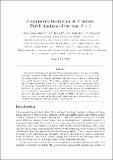N-symmetric interaction of N hetons. Part I. Analysis of the case N = 2
Abstract
We examine the motion of N symmetric hetons (oppositely signed vertical dipoles) in a two-layer quasi-geostrophic model. We consider the special case of N-fold symmetry in which the original system of 4N ordinary differential equations reduces to just two equations for the so-called “equivalent” heton. We perform a qualitative analysis to classify the possible types of vortex motions for the case N = 2. We identify the regions of the parameter space corresponding to unbounded motion and to different types of bounded, or localized, motions. We focus on the properties of localized, in particular periodic, motion. We identify classes of absolute and relative “choreographies” first introduced by Simó [“New families of solutions to the N-body problems,” in Proceedings of the European 3rd Congress of Mathematics, Progress in Mathematics Vol. 201, edited by C. Casacuberta, R. M. Miró-Roig, J. Verdera, and S. Xambó-Descamps (Birkhäuser, Basel, Barcelona, 2000), pp. 101–115]. We also study the forms of vortex trajectories occurring for unbounded motion, which are of practical interest due to the associated transport of heat and mass over large distances
Citation
Sokolovskiy , M , Koshel , K , Dritschel , D G & Reinaud , J N 2020 , ' N -symmetric interaction of N hetons. Part I. Analysis of the case N = 2 ' , Physics of Fluids , vol. 32 , no. 9 , 096601 . https://doi.org/10.1063/5.0019612
Publication
Physics of Fluids
Status
Peer reviewed
ISSN
1070-6631Type
Journal article
Description
Funding: This work was carried out as part of a joint project funded by the Russian Foundation for Basic Research (grant 20-55-10001) and UK Royal Society (grant IEC\R2\192170). MAS was also supported by the program 0147-2019-0001 (State Registration No.AAAA-A18-118022090056-0) and by the Ministry of Science and Education of the Russian Federation (Project No. N14.W03.31.0006), KVK was supp orted by RFBR project No.20-05-00083.Collections
Items in the St Andrews Research Repository are protected by copyright, with all rights reserved, unless otherwise indicated.

